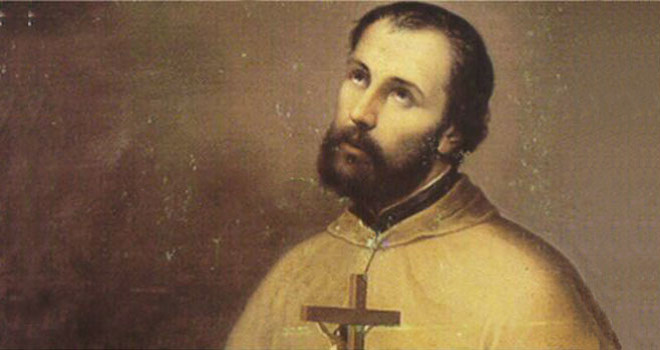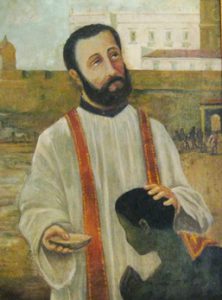
St. Peter Claver was a missionary priest, a recipient of extraordinary spiritual gifts, and a messenger of mercy and comfort to some of God’s most afflicted children. Peter was born in 1580 to Pedro and Ana Claver, the youngest of four children. The Clavers were farmers at Verdu, a town in Catalonian Spain. The parents were pious Catholics and the family gathered daily to pray the rosary. Ana died when Peter was thirteen, and the following year, he left to attend the Jesuit college at Barcelona, and was an exceptional student. When his education was completed there, Peter decided to join the Society of Jesus. He entered the novitiate at Tarragona when he was twenty two. While a novice, he made the difficult pilgrimage to the revered shrine of the Black Virgin of Montserrat, confirming his long-standing devotion to the Virgin Mary.
NOVITIATE AND A NEW MENTOR
As a novice, Peter was well liked, especially for his humility and concern for others. He made his first vows as a Jesuit brother upon his return, and was sent to complete his education at Montesion College on the island of Majorca. It was here that he would meet a mentor that would have a tremendous influence on his life. [St.] Alphonsus Rodriguez was a Jesuit lay brother, who served as a humble porter, but who had profound spiritual understanding and wisdom. A mystic who experienced numerous spiritual ecstasies, the elderly Brother Alphonsus immediately recognized in the the novice Peter Claver remarkable holiness and potential for a great future. Br. Alphonsus, after an angelic apparition, prophesied that Peter would bear tremendous fruit in the West Indies. Since there was no shortage of priests in Spain, he challenged the young novice to go to the New World to strike a balance against the mercenary exploitation of the natives and of the land and to bring a great harvest for the Lord’s kingdom. In 1608, Peter left Montesion in possession of Brother Alphonsus’ spiritual writings, which he treasured. He spent two more years studying theology at Barcelona, and made known his desire to be sent west as a missionary.

Peter was sent to New Granada, present day Columbia, with the blessing and provisions from Spain’s Catholic King Philip III, arriving at Cartagena in 1610. He spent five more years of study at Tunga, a mountainous monastery, and returned to his new home in Cartagena in the fall of 1615. He was ordained the following year at age thirty six. Cartagena was a port city and a regular flow of galleons arrived there, bringing entrepreneurs, pirates, fugitives, soldiers, and people of all races and creeds. It was also a main port for galleons bearing slaves from Africa, by the thousands. These most unfortunate people were being brought over to work on plantations or in mines. The slave traders were even more ruthless than the slave owners, and the captives arrived in wretched condition from unspeakable neglect. There was a Fr. Sandoval who had begun an apostolate to the slaves, and who had just begun to train Fr. Peter in this mission.
MISSION OF COMPASSION AND COMFORT
When Fr. Sandoval was sent to Peru, Fr. Peter accepted this apostolate as his own. He built a staff of eighteen former slaves to be interpreters in order to communicate effectively with the captives, no matter how remote their native dialect. He would board a slave ship upon its arrival, bringing foods and beverages to the afflicted. He would carry those who were most sickly to a hut, where he washed them and provided what medicines he was able to acquire by begging at the marketplace. He baptized the dying and brought the Gospel message and the Sacraments to the living, using a crucifix and artwork to illustrate the story of God’s salvation plan. He kept a chronicle of every person he baptized, and he followed up on each of them, even if it required long journeys. If they complained of mistreatment by their masters, he would implore the owners to change their ways.

During Fr. Peter’s years in Cartagena, there were five major outbreaks of disease, including typhoid and smallpox. He was well-known by the townspeople for bathing, nursing, and dressing with tender solicitude the most infected, even leprous people, black and white alike. He wore a large black cloak, and used it thousands of times to cover people and to wash wounds, but it miraculously always remained clean and sweet smelling. His cloak was also associated with numerous miraculous healings. He frequented St. Sebastian Hospital, St. Lazarus leprosarium, and some prisons. He organized an impressive choir for liturgies, and accompanied condemned prisoners to their executions. He had the gift of reading people’s souls. A man of many penances, Fr. Peter daily wore a full length hair shirt. He knew he could not ask anyone to carry a cross if he did not do likewise. In 1650, he contracted one of the many illnesses he exposed himself to, and collapsed at the Jesuit residence. Nearly paralyzed and beset by spiritual darkness, he lingered for three years. He died September 9, 1654 at age seventy four. People by the thousands of all colors and classes affectionately visited his body before burial.
A LIFE OF SELF-GIVING
St. Peter Claver brought comfort and hope to those who otherwise had little cause for hope on earth, restoring their inherent dignity as human beings. He knew he would never be able to obtain their freedom on earth, but by baptizing three hundred thousand people over forty years, he obtained for them the path to everlasting freedom. On his deathbed, Peter relinquished the writings of his beloved mentor, Alphonsus Rodriguez, and he bequeathed them to his former monastery at Tunga. He and Alphonsus were canonized together in 1896. St. Peter Claver is the patron saint of missionary efforts for black persons and of Columbia. His feast day is September 9.
